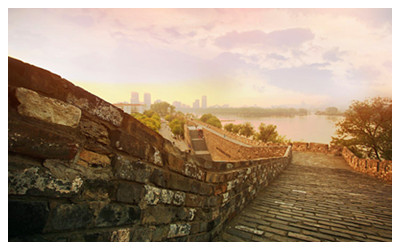
With 35.5 km, Nanjing City Wall built in the Ming Dynasty (1368-1644) is the longest city wall in the world . The second longest is the Paris City Wall at 29.5 km. With a history of over 600 years and built by Zhu Yuanzhang, the first Ming emperor, the city wall is truly splendid and one of the best preserved in China.
In 1366 AD Zhu Yuanzhang, the first Emperor of the Ming Dynasty, accepted the suggestion of a chancellor to build the Nanjing City Wall. After 21 years of painstaking constriction, the wall was finally completed in 1386. According to historical records, Zhu Yuanzhang ordered 118 counties of 20 states in 5 provinces to make bricks. Each brick weighs about 10 kilograms with a length of 40-50 centimeters (16-20 inches), a width of 20 centimeters (8 inches) and a height of 10 centimeters (4 inches). The bricks are inscribed with the names of officials who were responsible for the quality of the bricks. Up to 350 million bricks were used to build the wall.
The Nanjing City Wall is made up of four parts. From the outside first there is Outer City, Inner City, Imperial City and Palace City. In 1390, Outer City was built with a length of 180 kilometers (112 miles) in a diamond shape to strengthen defenses though it does not exist any more and only the names of the 18 gates are still used now. The Nanjing City Wall we can see today is mainly the relic of the Inner City. The Imperial City was built to protect the Palace City, which is nicknamed 'Forbidden City' as it is the centre of the four walls.
Located on the Southern Bank of the Yangtze River with abundant rainfall, rolling hills and meandering rivers, it is a difficult task to undertake such a huge project. However, the ancient Chinese conquered all the difficulties with their skills and built the walls by using materials appropriate for the terrain, creating Nanjing's City Wall with ever better scheme, physical feature and supreme location

Nanjing City Wall is an important cultural relic for the inscriptions on the bricks. The inscriptions come in two forms. One is from scholars and officials, the other from the artisan or folk people. The characters of the former is beautiful and elegant and contains the major calligraphic styles, the origin of one of the characters styles even cannot be traced. From here, you can see how Chinese characters developed and understand the multiculturalism of the Ming Dynasty. These inscriptions act like a historical scroll, recording the changes of the wall over dynasties. It provides an indispensable record for the study of Nanjing history.
Nanjing citizens attach great importance to the work of protecting Nanjing City Wall because the wall symbolizes the history of Nanjing. The local Municipal Government built a five-meter wide side path at Jiefangmen Gate for visitors to ascend. Although the completion of the Nanjing City Wall can not compete with
the City Wall of Xi'an, it is still the longest one in the World.
Getting There: Travelers could get there by taking Bus No. 44
 With 35.5 km, Nanjing City Wall built in the Ming Dynasty (1368-1644) is the longest city wall in the world . The second longest is the Paris City Wall at 29.5 km. With a history of over 600 years and built by Zhu Yuanzhang, the first Ming emperor, the city wall is truly splendid and one of the best preserved in China.
With 35.5 km, Nanjing City Wall built in the Ming Dynasty (1368-1644) is the longest city wall in the world . The second longest is the Paris City Wall at 29.5 km. With a history of over 600 years and built by Zhu Yuanzhang, the first Ming emperor, the city wall is truly splendid and one of the best preserved in China. Nanjing City Wall is an important cultural relic for the inscriptions on the bricks. The inscriptions come in two forms. One is from scholars and officials, the other from the artisan or folk people. The characters of the former is beautiful and elegant and contains the major calligraphic styles, the origin of one of the characters styles even cannot be traced. From here, you can see how Chinese characters developed and understand the multiculturalism of the Ming Dynasty. These inscriptions act like a historical scroll, recording the changes of the wall over dynasties. It provides an indispensable record for the study of Nanjing history.
Nanjing City Wall is an important cultural relic for the inscriptions on the bricks. The inscriptions come in two forms. One is from scholars and officials, the other from the artisan or folk people. The characters of the former is beautiful and elegant and contains the major calligraphic styles, the origin of one of the characters styles even cannot be traced. From here, you can see how Chinese characters developed and understand the multiculturalism of the Ming Dynasty. These inscriptions act like a historical scroll, recording the changes of the wall over dynasties. It provides an indispensable record for the study of Nanjing history. Ask Questions ?
Ask Questions ?